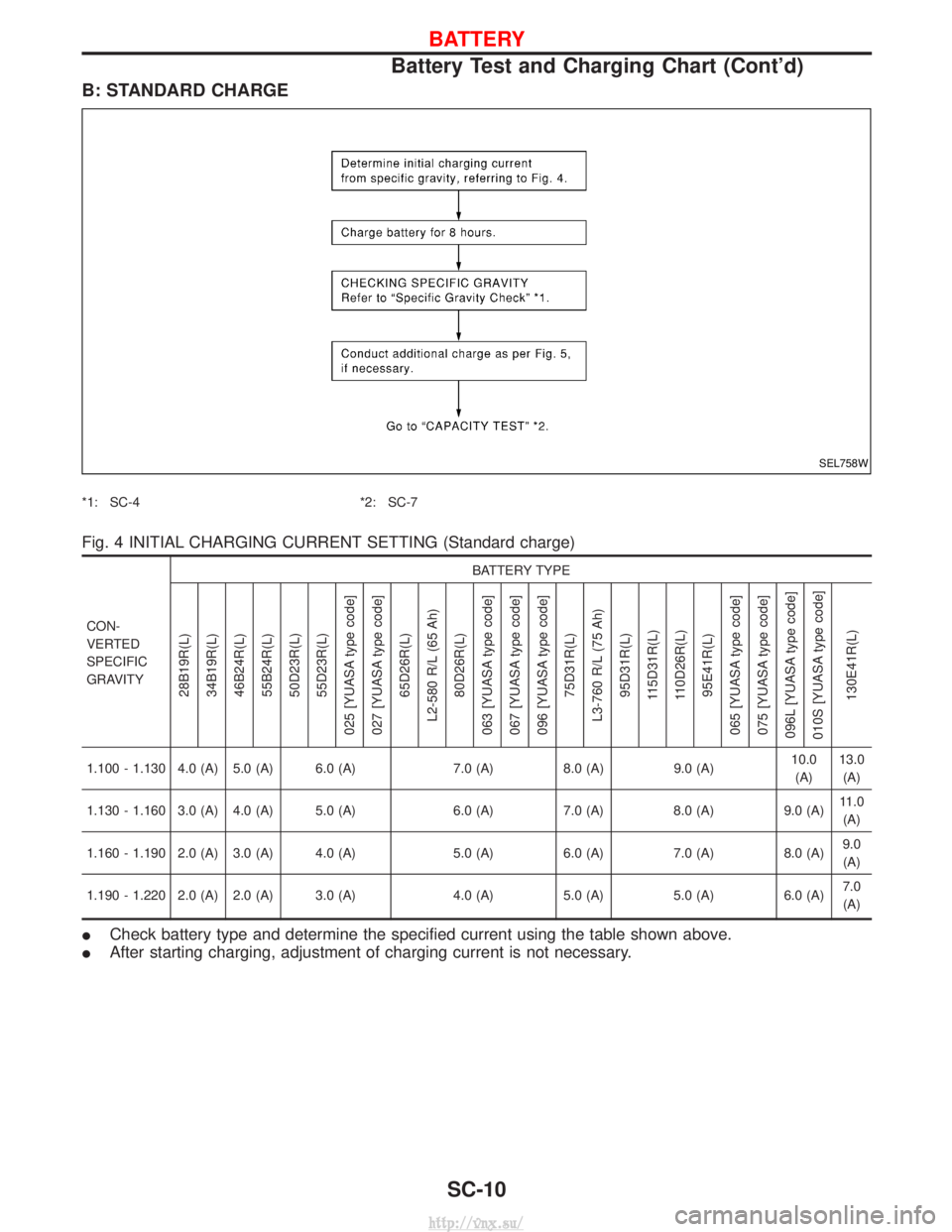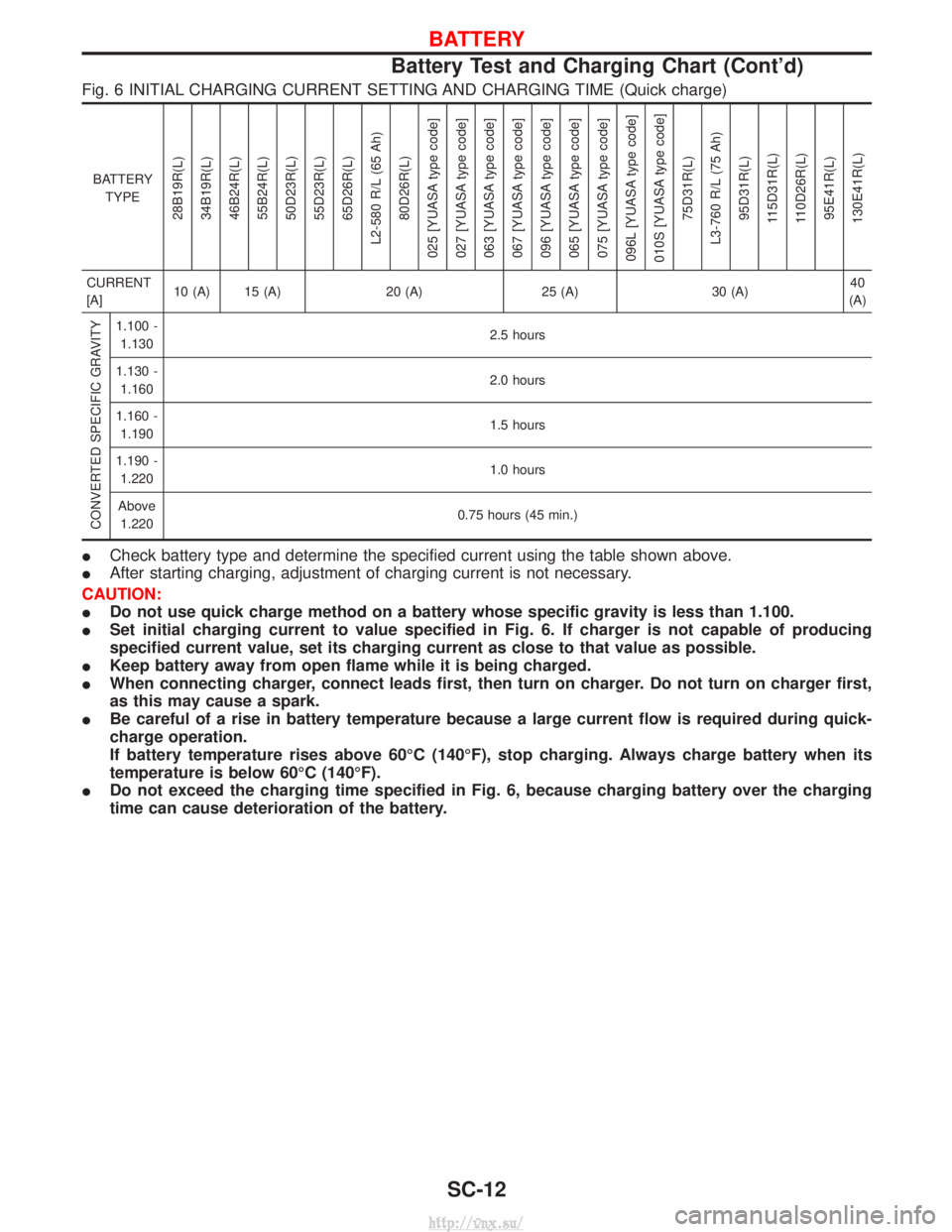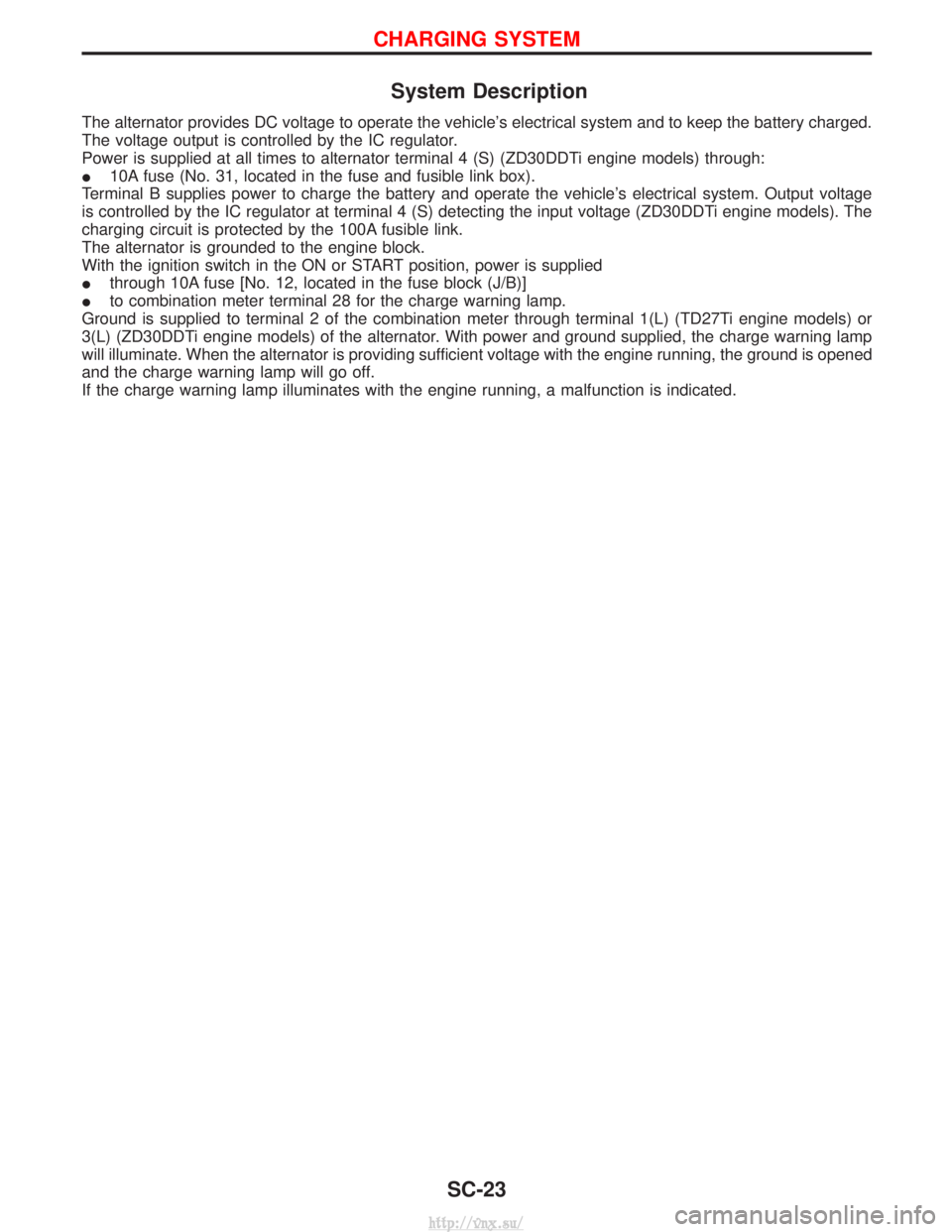Page 1469 of 1833
Battery Test and Charging Chart
CHART I
*1: SC-4
*2: SC-7*3: SC-8
*4: SC-10*5: SC-11
SEL754W
BATTERY
SC-6
http://vnx.su/
Page 1470 of 1833
CHART II
*: SC-6
ICheck battery type and determine the specified current using the following table.
Fig. 1 DISCHARGING CURRENT (Load Tester)
Type Current (A)
28B19R(L) 90
34B19R(L) 99
46B24R(L) 135
55B24R(L) 135
50D23R(L) 150
55D23R(L) 180
65D26R(L) 195
L2-580 R/L (65 Ah) 195
80D26R(L) 195
75D31R(L) 210
063 [YUASA type code] 210
L3-760 R/L (75 Ah) 225
95D31R(L) 240
115D31R(L) 240
025 [YUASA type code] 240
065 [YUASA type code] 255
027 [YUASA type code] 285
SEL755W
BATTERY
Battery Test and Charging Chart (Cont'd)
SC-7
http://vnx.su/
Page 1471 of 1833
TypeCurrent (A)
075 [YUASA type code] 300
110D26R(L) 300
95E41R(L) 300
067 [YUASA type code] 325
130E41R(L) 330
096 [YUASA type code] 375
096L [YUASA type code] 375
010S [YUASA type code] 360
A: SLOW CHARGE
*1: SC-4*2: SC-7
SEL756W
BATTERY
Battery Test and Charging Chart (Cont'd)
SC-8
http://vnx.su/
Page 1472 of 1833
![NISSAN TERRANO 2004 Service Repair Manual Fig. 2 INITIAL CHARGING CURRENT SETTING (Slow charge)
CON-
VERTED
SPECIFIC
GRAVITYBATTERY TYPE
28B19R(L)
34B19R(L)
46B24R(L)
55B24R(L)
50D23R(L)
55D23R(L)
025 [YUASA type code]
027 [YUASA type code] 6 NISSAN TERRANO 2004 Service Repair Manual Fig. 2 INITIAL CHARGING CURRENT SETTING (Slow charge)
CON-
VERTED
SPECIFIC
GRAVITYBATTERY TYPE
28B19R(L)
34B19R(L)
46B24R(L)
55B24R(L)
50D23R(L)
55D23R(L)
025 [YUASA type code]
027 [YUASA type code] 6](/manual-img/5/57394/w960_57394-1471.png)
Fig. 2 INITIAL CHARGING CURRENT SETTING (Slow charge)
CON-
VERTED
SPECIFIC
GRAVITYBATTERY TYPE
28B19R(L)
34B19R(L)
46B24R(L)
55B24R(L)
50D23R(L)
55D23R(L)
025 [YUASA type code]
027 [YUASA type code] 65D26R(L)
80D26R(L)
L2-580 R/L (65 Ah)
063 [YUASA type code]
067 [YUASA type code]
096 [YUASA type code] 75D31R(L)
L3-760 R/L (75 Ah) 95D31R(L)
115D31R(L)
110D26R(L) 95E41R(L)
065 [YUASA type code]
075 [YUASA type code]
096L [YUASA type code]
010S [YUASA type code]
130E41R(L)
Below 1.100 4.0 (A) 5.0 (A) 7.0 (A) 8.0 (A)8.5
(A) 9.0 (A) 10.0 (A) 11.0
(A) 14.0
(A)
I Check battery type and determine the specified current using the table shown above.
I After starting charging, adjustment of charging current is not necessary.
Fig. 3 ADDITIONAL CHARGE (Slow charge)
*: SC-7
CAUTION:
I Set charging current to value specified in Fig. 2. If charger is not capable of producing specified
current value, set its charging current as close to that value as possible.
I Keep battery away from open flame while it is being charged.
I When connecting charger, connect leads first, then turn on charger. Do not turn on charger first,
as this may cause a spark.
I If battery temperature rises above 60ÉC (140ÉF), stop charging. Always charge battery when its
temperature is below 60ÉC (140ÉF).
SEL757W
BATTERY
Battery Test and Charging Chart (Cont'd)
SC-9
http://vnx.su/
Page 1473 of 1833

B: STANDARD CHARGE
*1: SC-4*2: SC-7
Fig. 4 INITIAL CHARGING CURRENT SETTING (Standard charge)
CON-
VERTED
SPECIFIC
GRAVITY BATTERY TYPE
28B19R(L)
34B19R(L)
46B24R(L)
55B24R(L)
50D23R(L)
55D23R(L)
025 [YUASA type code]
027 [YUASA type code] 65D26R(L)
L2-580 R/L (65 Ah) 80D26R(L)
063 [YUASA type code]
067 [YUASA type code]
096 [YUASA type code] 75D31R(L)
L3-760 R/L (75 Ah) 95D31R(L)
115D31R(L)
110D26R(L) 95E41R(L)
065 [YUASA type code]
075 [YUASA type code]
096L [YUASA type code]
010S [YUASA type code]
130E41R(L)
1.100 - 1.130 4.0 (A) 5.0 (A) 6.0 (A) 7.0 (A)8.0 (A)9.0 (A) 10.0
(A) 13.0
(A)
1.130 - 1.160 3.0 (A) 4.0 (A) 5.0 (A) 6.0 (A) 7.0 (A) 8.0 (A) 9.0 (A) 11.0
(A)
1.160 - 1.190 2.0 (A) 3.0 (A) 4.0 (A) 5.0 (A) 6.0 (A) 7.0 (A) 8.0 (A) 9.0
(A)
1.190 - 1.220 2.0 (A) 2.0 (A) 3.0 (A) 4.0 (A) 5.0 (A) 5.0 (A) 6.0 (A) 7.0
(A)
I Check battery type and determine the specified current using the table shown above.
I After starting charging, adjustment of charging current is not necessary.
SEL758W
BATTERY
Battery Test and Charging Chart (Cont'd)
SC-10
http://vnx.su/
Page 1474 of 1833
Fig. 5 ADDITIONAL CHARGE (Standard charge)
*: SC-7
CAUTION:
IDo not use standard charge method on a battery whose specific gravity is less than 1.100.
I Set charging current to value specified in Fig. 4. If charger is not capable of producing specified
current value, set its charging current as close to that value as possible.
I Keep battery away from open flame while it is being charged.
I When connecting charger, connect leads first, then turn on charger. Do not turn on charger first,
as this may cause a spark.
I If battery temperature rises above 60ÉC (140ÉF), stop charging. Always charge battery when its
temperature is below 60ÉC (140ÉF).
C: QUICK CHARGE
*: SC-7
SEL759W
SEL760W
BATTERY
Battery Test and Charging Chart (Cont'd)
SC-11
http://vnx.su/
Page 1475 of 1833

Fig. 6 INITIAL CHARGING CURRENT SETTING AND CHARGING TIME (Quick charge)
BATTERYTYPE
28B19R(L)
34B19R(L)
46B24R(L)
55B24R(L)
50D23R(L)
55D23R(L)
65D26R(L)
L2-580 R/L (65 Ah) 80D26R(L)
025 [YUASA type code]
027 [YUASA type code]
063 [YUASA type code]
067 [YUASA type code]
096 [YUASA type code]
065 [YUASA type code]
075 [YUASA type code]
096L [YUASA type code]
010S [YUASA type code] 75D31R(L)
L3-760 R/L (75 Ah) 95D31R(L)
115D31R(L)
110D26R(L) 95E41R(L)
130E41R(L)
CURRENT
[A] 10 (A) 15 (A) 20 (A) 25 (A) 30 (A) 40
(A)
CONVERTED SPECIFIC GRAVITY
1.100 - 1.130 2.5 hours
1.130 - 1.160 2.0 hours
1.160 - 1.190 1.5 hours
1.190 - 1.220 1.0 hours
Above 1.220 0.75 hours (45 min.)
I
Check battery type and determine the specified current using the table shown above.
I After starting charging, adjustment of charging current is not necessary.
CAUTION:
I Do not use quick charge method on a battery whose specific gravity is less than 1.100.
I Set initial charging current to value specified in Fig. 6. If charger is not capable of producing
specified current value, set its charging current as close to that value as possible.
I Keep battery away from open flame while it is being charged.
I When connecting charger, connect leads first, then turn on charger. Do not turn on charger first,
as this may cause a spark.
I Be careful of a rise in battery temperature because a large current flow is required during quick-
charge operation.
If battery temperature rises above 60ÉC (140ÉF), stop charging. Always charge battery when its
temperature is below 60ÉC (140ÉF).
I Do not exceed the charging time specified in Fig. 6, because charging battery over the charging
time can cause deterioration of the battery.
BATTERY
Battery Test and Charging Chart (Cont'd)
SC-12
http://vnx.su/
Page 1486 of 1833

System Description
The alternator provides DC voltage to operate the vehicle's electrical system and to keep the battery charged.
The voltage output is controlled by the IC regulator.
Power is supplied at all times to alternator terminal 4 (S) (ZD30DDTi engine models) through:
I10A fuse (No. 31, located in the fuse and fusible link box).
Terminal B supplies power to charge the battery and operate the vehicle's electrical system. Output voltage
is controlled by the IC regulator at terminal 4 (S) detecting the input voltage (ZD30DDTi engine models). The
charging circuit is protected by the 100A fusible link.
The alternator is grounded to the engine block.
With the ignition switch in the ON or START position, power is supplied
I through 10A fuse [No. 12, located in the fuse block (J/B)]
I to combination meter terminal 28 for the charge warning lamp.
Ground is supplied to terminal 2 of the combination meter through terminal 1(L) (TD27Ti engine models) or
3(L) (ZD30DDTi engine models) of the alternator. With power and ground supplied, the charge warning lamp
will illuminate. When the alternator is providing sufficient voltage with the engine running, the ground is opened
and the charge warning lamp will go off.
If the charge warning lamp illuminates with the engine running, a malfunction is indicated.
CHARGING SYSTEM
SC-23
http://vnx.su/